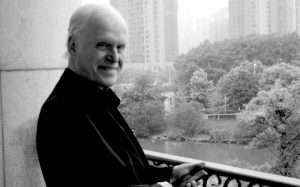Professor Derek Clements-Croome has been promoting efficient and effective ventilation in the workplace since 1975. As the easing of lockdown restrictions sees people returning to offices, this research has become more relevant than ever.
Since Professor Clements-Croome joined Reading’s School of the Built Environment in 1988, he has used his expertise on health and wellbeing in the workplace to encourage businesses to create sustainable, liveable architecture. He firmly believes that the healthier your staff are, the more efficient and cost-effective your business will be.

Now an Emeritus Professor of Architecture and Engineering at Reading, Professor Clements-Croome speaks to CONNECTED about what employers should be considering while making their offices COVID-19 secure.
Improving ventilation
Following Boris Johnson’s announcement that staff can return to the office from 1 August, if the workplace is COVID-19 secure, the research that Professor Clements-Croome has been leading on – which stretches back decades – has suddenly been propelled into the spotlight.
Professor Clements-Croome explains: “I am on the research committee of the British Council for Offices [BCO], whose members are drawn from organisations involved in creating, acquiring or occupying office space.
“I am working with many individual researchers to bring research together and find solutions to enable office workers to return as safely as possible amidst the pandemic. We are looking primarily at ventilation, airborne transmission and how virus droplets spread via surfaces.
“My first book, which came out in 1975, included a chapter on air movement in rooms – looking back, that chapter was spot on to today’s situation. The problem with ventilation systems is that ventilation can be tested and classified as efficient if you simply measure how much air is going into a room. However, you also need to ensure that air is impacting the breathing zone around people in the room – if it doesn’t then you have an ineffective air flow. So you need to look at how the air is distributed around the room, not just how it enters the room.
“That should have been happening before COVID-19 anyway. Now with the pandemic, employers need to go one step further and consider how the air can lift the virus droplets away from the occupancy zone. Essentially, there is a carpet of droplets that needs to be lifted above people and extracted from the building. This air needs to be filtered and cleaned – it cannot simply be dumped outside due to the potential virus droplets contained within it.
“While the issue of ventilation has been taken increasingly seriously over the past decades, ultimately a lot of industries are controlled by manufacturers and prices, so in reality, ventilation has not been researched as widely as it needs to be.”
Basic solutions
While some businesses may feel they cannot afford to install a potentially expensive air filtering system, Professor Clements-Croome explains that there are a number of basic and value for money factors that should be considered.
He said: “Buildings should preferably have accessible open windows. This, of course, depends on your type of environment – whether rural and low-pollution, or noisy and high-pollution – but if you can open windows more this is a free, environmentally-friendly way of increasing good air flow. Arranging the type of window in relation to the form and geometry of the space is important too.
“Other factors like installing protective screens, minimising the use of shared items such as kettles, increasing hand-sanitiser or limiting the number of people in meeting rooms, will all be beneficial in reducing the risk of spreading infectious diseases in the workplace.
“Increasing people’s space in offices is also important. Traditionally the average office allowed eight square metres per person, but that has been diminishing over time alongside an increase in hot desking.
“This needs to be reconsidered, and it’s not just because of COVID-19: the more people you throw together, the more you increase their stress levels as well as their infection risk.”
Investing in health and wellbeing
Professor Clements-Croome is a strong advocate for investing money and thought into the health and wellbeing of your staff, to reap benefits in the future.
He explains: “While the cost of installing an efficient ventilation system may put some employers off, I always encourage businesses to consider the value of their employees’ health. If all your employees become unwell, that costs your company money. So investing money now into improving your workplace environment can save money in the long-term, especially given the current circumstances.
“We also need to ensure we don’t exclude people in these ideas. For example, lifts present an issue of too many people crowding into a confined space, but you can’t just tell everyone to use the stairs more, as that isn’t an option for elderly or disabled people. We need to make sure we’re having a balanced argument that isn’t exclusive.
“There are benefits to implementing these changes beyond infection control, so even if we do find a COVID-19 vaccine, these factors will still be valid.
“This is our opportunity to undertake more measuring to understand how the environment is affecting people and enhance our working environments, as well as improving human connectedness in the workplace.”
Influencing the industry
Professor Clements-Croome actively uses his research to try and promote better practices in the workplace. His work has recently fed into a BCO thought paper on Office Design and Operation after COVID-19, and he was one of 239 signatories on a letter urging the World Health Organisation (WHO) to revise its recommendations based on the evidence that COVID-19 can be spread via smaller airborne particles. He was also one of the contributing authors to the WHO report in 2009 on ventilation and infection risk.
He said: “As well as guest lecturing at Reading to promote these ways of thinking in our approach to the built environment, and my long-standing work with BCO, I have also contributed, alongside many others, to the work of the Government, including the House of Lords on a paper titled Building Better Places [reference HL Paper 100], to try and improve the effects of the built environment on people. However, progress on such work with the Government is unfortunately slow.
“Therefore employers need access to research on how to improve their workplaces, so they can make their own informed decisions to not only protect employees from COVID-19, but also improve the general health and wellbeing of the national workforce. Doing so would save costs for the NHS as well as improving productivity.”
Find out more about Professor Clements-Croome’s research.




